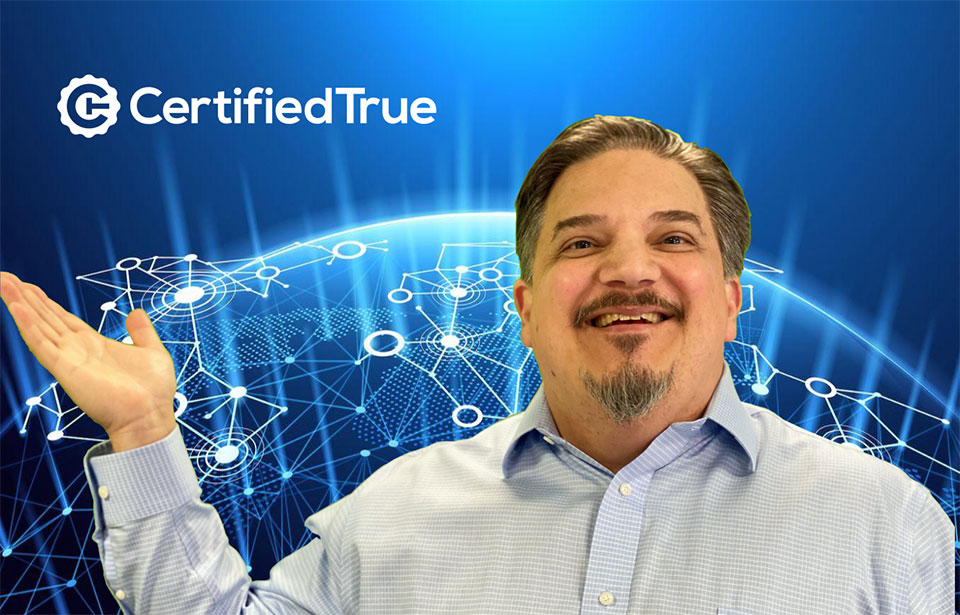CEO Spotlight: CertifiedTrue CEO Stephen Graves on how the next wave of blockchain technology is going to impact business

Recently, a lot is being made of the Metaverse and Non Fungible Tokens, while the hype about how blockchain and decentralization will transform business as we know it has been going on for several years. To make some sense of it, and what it means for CEOWORLD magazine readers, I thought I would ask Stephen Graves, who is CEO of CertifiedTrue, a startup that uses blockchain to provide image verification. Previously, Stephen ran new product incubation at enterprise software provider CA Technologies and has a 25+ year career founding technology-based startups and consulting for government and enterprise clients.
Many people are talking about how Web 3.0 is going to replace many of the existing technology structures, including those in enterprise platforms. You lead a blockchain startup. Do you think that is accurate and if so, when?
Stephen Graves: So there is a lot of excitement and investment in the push for Web3 (decentralized, blockchain) technologies. At the same time, a lot of corporate and business applications are still struggling to fully integrate even Web 2.5 (cloud). Certain industries that depend on information processing systems like Legal, Insurance, and Real Estate still use an astonishing amount of paper and have legacy human processes beyond technical integration where it can be difficult to get buy-in for real change.
Another expectation of Web3’s concept of decentralization is that people are willing to give up a lot of privacy to get convenient features. Businesses don’t work that way and access control, rights management, and data privacy are core requirements. Most executives simply don’t feel that comfortable with purely algorithmic decentralized governance and so they are looking for a solutions vendor they can trust that can ensure service levels. That doesn’t happen with most open-source blockchain projects. However, what blockchain (and more generally, distributed ledger technology) does very well is to provide data replication and provenance that can be reliably verified.
That’s why I believe the real growth is going to come from the fusion of Web 3.0 with Web 2.5 rather than replacing it. When we started out building our own blockchain platform in 2018 to support our main photo verification application, we eventually realized that to escape “Zamfir’s triangle” on scalability, security, and decentralization, we would need to create a hybrid system using both cloud and blockchain technologies. In the end, this gave us the best of both worlds and I suspect this is where the real action is going to happen over the next 5 years.
Are you saying the future is not in Non Fungible Tokens?
Stephen Graves: Ha! Someone on our team jokingly told me that instead of actually developing a product, we should just build a digital bucket and announce that it makes NFTs, then step back and watch the money pour into it like rain before heading off in a yacht to our own private island. But no, we have to be the crazy people actually trying to create technology to solve existing business problems. NFTs are just one application of distributed ledger technology. The current state of NFTs is a bubble and it is going to crash down to earth at some point. I mean, how much are Crypto Kitties going for now? But like previous tech waves like blockchain, cloud, and e-commerce, I believe the real value in NFTs is in the underlying technology being applied to real-world issues and that value should only grow over time. Meanwhile, I have friends who are minting fortunes in NFTs. Hopefully, I can borrow their yacht from time to time.
So how does CertifiedTrue solve “a real-world issue”?
Stephen Graves: Our world is becoming more digitized every day and the most important information comes to us from a screen. When we see pictures or videos, we tend to believe them and that can be an issue when the images have been manipulated to skew the story they tell you. It has become so easy to indiscernibly manipulate a photo it’s almost impossible to be sure what is real anymore. That’s a huge problem for a lot of industries, like Insurance and Real Estate, where manipulated images are used to commit fraud that costs companies untold billions of dollars every year. In the courts as well, where I see the number of cases that hinge on photo or video evidence being challenged growing by the day.
What CertifiedTrue’s PhotoProof solution does is enable you to take tamperproof photos that can be easily verified by others. Just take a photo from your phone with our mobile app, and it is cryptographically sealed, uploaded into a special vault in the cloud, and recorded on an immutable ledger with all its provenance (time/date/location, etc). Anyone, you give the photo to can use the reference number or the photo file itself to verify it on our site. If a single-pixel or one bit of reference data is changed, the photo will no longer be verifiable. Businesses can further manage the images in our web app as well, adding tags and notes or assigning them to cases, etc. There are a lot of use cases but we see insurance and police as our biggest target industries.
Blockchain technology would seem to have a lot of promise but there has also been a lot of hype in the past 5 years with companies complaining of a limited amount of real ROI. Any advice on how companies can get the benefits without running into pitfalls?
Stephen Graves: There is a lot to parse there really. First, it is important to be sure that you really need blockchain or do you just need some of the components of one. Note that a blockchain is a complex multilayer package of technologies operating as a unified platform but itself is merely a subset of the larger concept of distributed ledger technologies (DLT). Many of the subcomponents of blockchain have matured enough to have modular applications available instead of having to utilize a bloated platform with the whole gamut of crypto, consensus, runtime engine, etc.
The key is to consider your use case and break it down into its business process components, then chose the technology modules that can deliver the primary value chain of that process without the unnecessary technical overhead. The need for an application for airplane parts to ensure provenance across a supply chain is very different than one for low ticket value exchange between multiple unknown parties. The real magic trick usually is getting the necessary modules to work together and then interoperate with any other backend systems they need to exchange data with.
So, to recap: 1) think modular; 2) define the business process the tech will handle; 3) select frameworks, platforms, and/or apps that meet those needs without a lot of additional functionality you don’t use; and, 4) the challenge is usually integration with legacy data. On this last point, that is another reason why I see the best hybrids using both cloud and blockchain technologies, since interfaces to various cloud vendors are much more mature in the development cycle, making it easier to connect legacy data systems.
Have you read?
# Best CEOs In the World Of 2022.
# TOP Citizenship by Investment Programs, 2022.
# Top Residence by Investment Programs, 2022.
# Global Passport Ranking, 2022.
# The World’s Richest People (Top 100 Billionaires, 2022).
Add CEOWORLD magazine to your Google News feed.
Follow CEOWORLD magazine headlines on: Google News, LinkedIn, Twitter, and Facebook.
Copyright 2024 The CEOWORLD magazine. All rights reserved. This material (and any extract from it) must not be copied, redistributed or placed on any website, without CEOWORLD magazine' prior written consent. For media queries, please contact: info@ceoworld.biz








